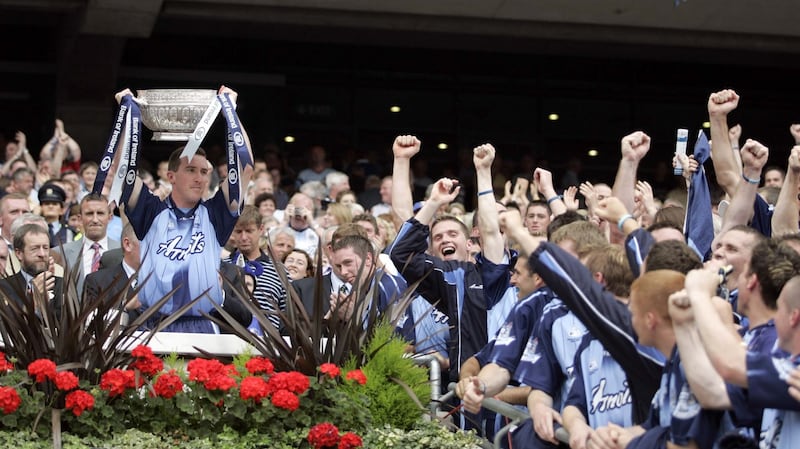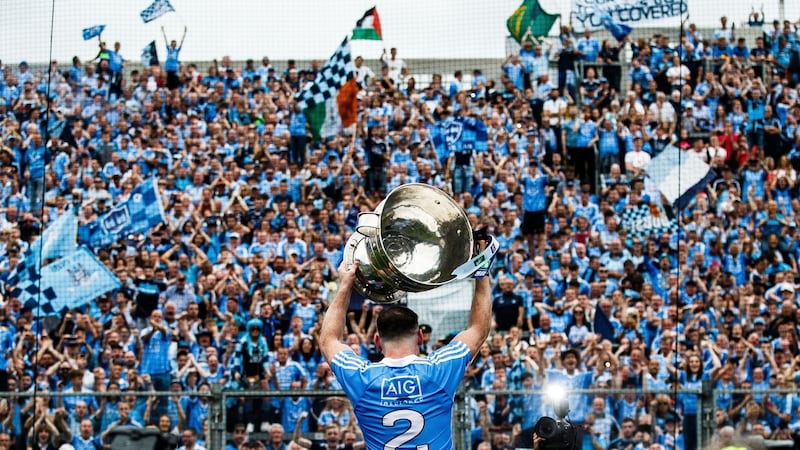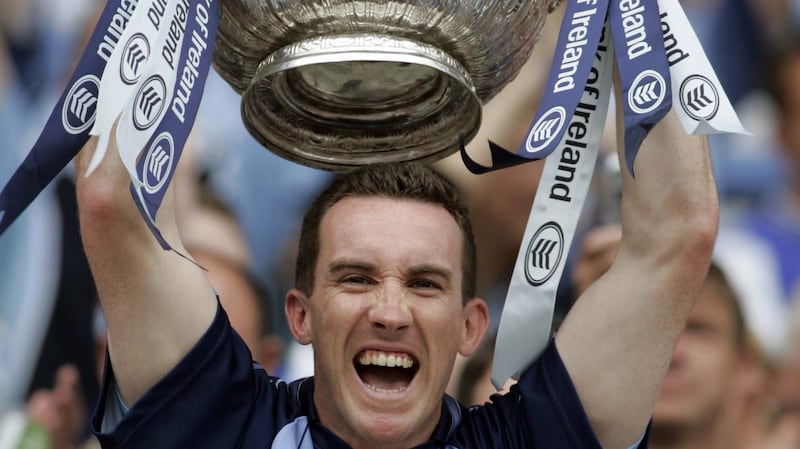There are two sides to every story, except when it comes to the state of Gaelic football, for which there about 200. The inter-county season has ended on a conflicted note of national awe at the power and polish with which Dublin retained the Sam Maguire for the fourth consecutive year and general disquiet at the challenge which the city team now presents.
Their success makes them appear as the Empire. In his captain’s speech Stephen Cluxton paid tribute to the Dublin county board, pointedly stating that “regardless of what people say about money and population, to put these teams out and really, we really go as hard as we can . . . ”
It was a strange moment: an unexpected recognition of a counterargument. There is little doubt that county chairpersons and treasurers around the country read with envy and, probably, despair of the huge sums of money invested in Dublin GAA over the past decade. But few have yet to make noises publicly.
The fast conclusion is that the old provincial championship model and county versus county appeal has reached the end of the tracks.
Its success was always dependent on Dublin, a sleeping giant in terms of population, grossly under-achieving. In winning 28 All-Irelands in clusters, Dublin have been quite obliging in this regard until this decade, when they got their act together from the grassroots up.
In short, they did a Dermot Bannon job on the entire gaff. The front-of-house benefits of this radical overhaul have been dynastic: six All-Irelands and five leagues; the finished-article seasons of Brian Howard and Niall Scully; the collective strength and athleticism of senior players like Ciarán Kilkenny and Jack McCaffrey; and, overseeing everything, the serene comportment of Jim Gavin.
Inevitable outcome
It took Dublin 34 years to win the four championships that succeeded this peerless run. A Dubs success just over once a decade: the nation could live with that. There is general alarm that Dublin’s march to All-Ireland football titles will become the inevitable outcome of the championship. And with that the accusation that this senior success is down to money. It is difficult for any Dublin supporter – and impossible for anyone directly involved in the team – not to interpret this as a slur.
“I do get annoyed,” admits Paddy Christie.
“It doesn’t keep me awake but I find it slightly insulting, personally and for the county, when people write it off as money. I suppose this is the opposite of crying the poor mouth – it is the rich mouth. But a lot of the groundwork had nothing to do with money in my eyes. It has been happening for years in Dublin in terms of people giving their time. Where the millions come in is probably the full-time coaches.
“And, yes, it is powerful to have a coach with every club. But it is only one factor in a myriad. I think it is lazy punditry. Money has come in from Croke Park and from AIG, but it must be used properly as well. We have seen countless examples in sport and business where money is wasted. It wasn’t inevitable: there was a lot of careful thought put in and coaching meetings. And I can vouch there was no money involved in those. You were just asked to come down for two hours and give your thoughts at a workshop.”

Christie has just started as principle in Kilcoskan national school, on the old Ashbourne road in north Dublin. He’s been coaching all his adult life. When he played for Dublin, he formed the Ballymun Kickhams representation along with Ian Robertson. Now, there are six players from the club on the senior panel. It’s an impressive representation.
And it’s one of which he is justifiably proud. Philly McMahon, Alan Hubbard and Sean Currie were among the group that he began coaching as teenagers because there was nobody else around to do it. And it wasn’t as if his wall was festooned with coaching credentials at the time.
“I had done a one-day course for the summer camps,” he says. “I had to hope for the best and maybe I was predisposed to teaching and coaching in that it ended up becoming my career.”
But he recalls when so much about Dublin football was off-the-cuff and down happenstance. In one of the years when he was eligible for Under-21, the county simply didn’t enter a team. Games were cancelled in the blink of an eye. Sometimes now he visits other counties and hears stories that remind him of the city structure of his teenage years: games called off; promising juvenile teams waiting months for leagues to begin.
The huge transformation within Dublin, as he sees it, lies in the cohesion and organisation of leagues at juvenile level. The fixtures are up on Hill16.ie. A team must jump through hoops if they want a late cancellation. The general emphasis, under Stephen O'Shaughnessy, is on coaching the fundamental skills. It means that that when the best players come through, it simplifies the task for the coaches that Christie terms "the finish-off-errs": Pat Gilroy and Dessie Farrell and Jim Gavin.
“They probably wouldn’t be able to have as much of an effect with very young players, but they can take a conveyer belt and fashion that raw material into success at a later age.”
Christie is as reasonable as they come. He can see the benefits of the funding Dublin has received. He readily admits that if the worst fears materialise and the Dublin senior team canters to the next four All-Irelands, it would not be good for the game in general.
“I think all of this was done for a good reason. Dublin had – and still has – patches around the city and county where the GAA was a third-class citizen. And the decision was taken to try and develop the game in the city. It just so happened that because it was done quite well, it has caused a problem.”
The bad news, for the other counties, is that there is potential for further growth. Finglas/Erins Isle are in division three at adult level and aren’t setting off fireworks at under-age level. And there’s a catchment of over 40,000 people surrounding the club. The potential is enormous.
Revolution
However, one of the inadvertent problems caused by the revolution in the city is that there are loads more players of inter-county calibre but only 26 squad places available. It goes back to the issue raised by the Strategic Review Committee in 2003 and the notorious proposal to split the county so there could be two teams.
“People automatically saw that as an attack on Dublin but the clever way of looking at it was that it was giving more players a chance to represent Dublin,” says Christie.

“It had solid foundations in that it had merit. I’m probably going to have a thousand keyboard warriors saying ‘oh, that idiot is saying Dublin should be split in two’. I’m not saying that but from a coaching point of view, it had merit. There will be very good players who just won’t be able to break into the Dublin squad. And I’d be lying if I said that that isn’t a concern. And I’m worried about the repercussions from a Ballymun point of view.”
An excess of high-quality, inter-county standard footballers, is, of course, served up as the ultimate proof of Dublin’s new invincibility. At county board meetings all over Ireland, the discussion is focused on the more fundamental business of just keeping the show on the road.
Kevin McStay’s statement this week, in which he stepped down as Roscommon manager, and from inter-county management in general, reflected the demands of the contemporary role. The lone figure at centerfield, whistle in mouth, has become an archetype.
A modern manager is more like the chief executive of a small firm. Roscommon won a famous Connacht final in Salthill, were promoted to division one and made it to this year’s Super 8s under McStay’s watch.
It’s hard to see how he could have achieved much more. Like Gavin, McStay is of the military and forensic in his potential to detail. In his statement, he takes time to praise the platoon of behind-the-scenes staff and players.
He also noted: “In reviewing my time in charge I have to acknowledge the inordinate amount of time I spent dealing with financial and facility issues, personnel issues, media issues and the various contentious and controversial events that kept arising over those seasons.”
It’s a bleak summary that will probably ring true for most inter-county managers, who are unanimous in their feeling that there aren’t enough hours in the day. County boards are tasked with the twin obligations of developing the game within their jurisdiction and coming up with the funds required to run a county squad. Supporters don’t care about the costs of keeping that show on the road: they just want to see their team doing well.
The lapse of the Leinster championship into a race for runner-up to Dublin has led to the fast conclusion that we are now seeing Dublin's provincial domination being replicated on the national stage. Kildare and Meath have suffered most in comparison to Dublin. Both are established football counties with growing populations. Neither have been able to pose a serious challenge to Dublin at senior level since 2010.
However, it was those two counties that contested the Leinster minor final in the summer. And Kildare beat Dublin by 1-15 to 0-10 on their way to winning the All-Ireland Under-20 championship this year.
“There was huge respect but no real fear among this age group of Dublin, says Davy Burke, the Confey man who managed that team. Burke is optimistic that his county have now put in place coaching structures like those in Dublin. But Dublin have had their programmed streamlined for over a decade.

“It is about numbers and we have the population in Kildare – even if you are competing with rugby and soccer. I think it was critical that we got our house in order. And we have done but it won’t be today or tomorrow that you see the result.”
Burke is hopeful, too, that five or six of this year’s championship side can break into the senior squad and that players like Jimmy Hyland can graduate into first-team prospects.
“They all want to be senior players for Kildare, which is a massive thing. You have to want it. It is grand in Croke Park . . . we all want to play in front of 82,000 but do you want to go to Hawkfield on a wet Wednesday in January? And you are #32 because you are just in the door and getting beaten up on by Eoin Doyle? You have to want to go through that. And these guys want to make that step.”
When they do, they will, at some stage, encounter a Dublin senior team that Burke believes happen to be “one of the greatest of all time.
“And it doesn’t look like they are satisfied just yet. With five in a row looming, who would want to leave that set-up? Dublin are the benchmark.”
That gets to the heart of the divergent viewpoints on the All-Ireland champions.
Material advantage
On Friday, former player Alan Brogan passionately rejected the insinuation that Dublin's six All-Irelands since 2011 are attributable to material advantage. "All that's in St Clare's is one dressingroom, an ice-bath, a kitchen and a whiteboard," he wrote in his column. "It's not a patch on Tyrone's facility in Garganey, Kildare's in Hawkfield or Kerry's new €7 million development in Currans. Not a patch.
“Nobody gets their dinners delivered to them and the mileage is less than players in other counties get because generally speaking, they don’t travel as far.”
Brogan’s argument is simple: that the last four years are the result of heightened levels of dedication by a group of players who had exceptional talent to begin with.
And it would be churlish and plain stupid to deny that this Dublin team are great. Christie reckons that the assumption that there are innumerable versions of Howard or Brian Fenton just waiting in the shadows of the Dublin structure is misplaced. "I would imagine that the line has slowed down already, he says. "Other counties will catch up and the inevitable slow down here is coming."
There are countless theories on what will happen next. It just so happens that Dublin's four-in-row era coincides with a period when other traditionally strong counties have been in comparatively fallow periods. Kerry have been effectively rebuilding from the team that won the 2014 championship. Mayo gave Dublin a genuine rivalry but their heroic side is running out of time. It remains to be seen whether teams like Monaghan, Galway, Tyrone and Donegal can further narrow the gap next summer. If they can't and Dublin keep on winning, then the cries of "unfair" will become louder.
And even if some county unexpectedly explodes into form next summer and beats Dublin, it won’t change the picture in the long term.
The city game was chugging merrily and inefficiently for years, still basking in the hue of the Heffernan era and gamely pretending that the rivalry against Kerry was a real thing. Now, with startling suddenness, reality has been altered.
The word “machine” has crept into the conversation about Dublin this summer, with its implications that the players are merely parts that can be replaced. It is, of course, slyly derogatory and unfair. The Dublin players and management are, for all the carping, amateurs, with other commitments and other lives. To reach the level they have done has, clearly, required phenomenal discipline and practice.
It remains to be seen what happens when Gavin steps down. It remains to be seen if Dublin can, in fact, seamlessly replace figures like Cluxton and Cian O’Sullivan or McMahon when they decide to call time. And it remains to be seen how Dublin will perform whenever James McCarthy, a once-in-a-generation player, retires.
The ironic and, for them, infuriating thing is that only if and when Dublin stop winning senior All-Irelands will the achievements of the Gilroy-Gavin era and the generation of players become fully apparent and lauded without equivocation.













